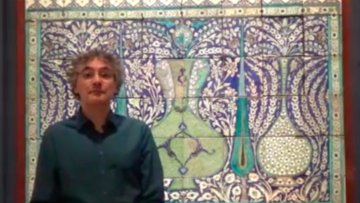Beauty is in the eye of the beholder, but what about symmetry? In our final feature on mathematicians let loose in the Ashmolean Museum, Oxford Mathematician Balázs Szendrői investigates the beauty of symmetry in the Museum's Islamic art works. As he explains, no matter what the tile pattern may look like, its underlying symmetry configuration belongs to a small set of possibilities.
Elementary Applied Topology
Abstract
In this meeting we will talk about the first two chapters of Robert Ghrist's book "Elementary Applied Topology". The book is freely available at the following link: https://www.math.upenn.edu/~ghrist/notes.html
Hyperbolic Dehn filling in dimension four
Abstract
By gluing copies of a deforming polytope, we describe some deformations of complete, finite-volume hyperbolic cone four-manifolds. Despite the fact that hyperbolic lattices are locally rigid in dimension greater than three (Garland-Raghunathan), we see a four-dimensional analogue of Thurston's hyperbolic Dehn filling: a path of cone-manifolds $M_t$ interpolating between two cusped hyperbolic four-manifolds $M_0$ and $M_1$.
This is a joint work with Bruno Martelli.
11:00
Community Detection in Annotated Bipartite Networks
Abstract
A successful programme of personalised discounts and recommendations relies on identifying products that customers want, based both on items bought in the past and on relevant products that the customers have not yet purchased. Using basket-level grocery shopping data, we aim to use clustering ("community detection") techniques to identify groups of shoppers with similar preferences, along with the corresponding products that they purchase, in order to design better recommendation systems.
Stochastic block models (SBMs) are an increasingly popular class of methods for community detection. In this talk, I will expand on some work done by Newman and Clauset [1] that uses a modified SBM for community detection in annotated networks. In these networks, additional information in the form of node metadata is used to improve the quality of the inferred community structure. The method can be extended to bipartite networks, which contain two types of nodes and edges only between nodes of different types. I will show some results obtained from applying this method to a bipartite network of customers and products. Finally, I will discuss some desirable extensions to this method such as incorporating edge weights and assessing the relationship between metadata and network structure in a statistically robust way.
[1] Structure and inference in annotated networks, MEJ Newman and A Clauset, Nature Communications 7, 11863 (2016).
Note: This talk will cover similar topics to my presentation in the InFoMM group meeting on Friday, November 25 but it won't be exactly the same. I will focus more on the mathematical details for my JAMS talk.
Quasi-convexity and Howson's Theorem
Abstract
This talk will introduce the notion of quasi-convex subgroups. As an application, we will prove that the intersection of two finitely generated subgroups of a free group is again finitely generated.
Modelfree portfolio optimization in the long run
Abstract
Cover’s celebrated theorem states that the long run yield of a properly chosen “universal” portfolio is as good as the long run yield of the best retrospectively chosen constant rebalanced portfolio. We formulate an abstract principle behind such a universality phenomenon valid for general optimization problems in the long run. This allows to obtain new results on modelfree portfolio optimization, in particular in continuous time, involving larger classes of investment strategies. These modelfree results are complemented by a comparison with the log-optimal numeraire portfolio when fixing a stochastic model for the asset prices. The talk is based on joint work with Walter Schachermayer and Leonard Wong.
Inequality in a monetary dynamic macroeconomic model
Abstract
Thomas Piketty's influential book “Capital in the Twenty-First Century” documents the marked and unequivocal rise of income and wealth inequality observed across the developed world
in the last three decades. His extrapolations into the distant future are much more controversial and has
has been subject to various criticisms from both mainstreams and heterodox economists. This motivates the search for an alternative standpoint incorporating
heterodox insights such as endogenous money and the lessons from the Cambridge capital controversies. We argue that the Goodwin-Keen approach paves the road towards such an alternative.
We first consider a modified Goodwin-Keen model driven by consumption by households, instead of investment by firms, leading to the same qualitative features
of the original Keen 1995 model, namely the existence of an undesirable equilibrium characterized by infinite private debt ratio and zero employment,
in addition to a desirable one with finite debt and non-zero employment. By further subdividing the household sector into workers and investors, we are able to investigate their relative
income and wealth ratios for in the context of these two long-run equilibria, providing a testable link between asymptotic inequality and private debt accumulation.


